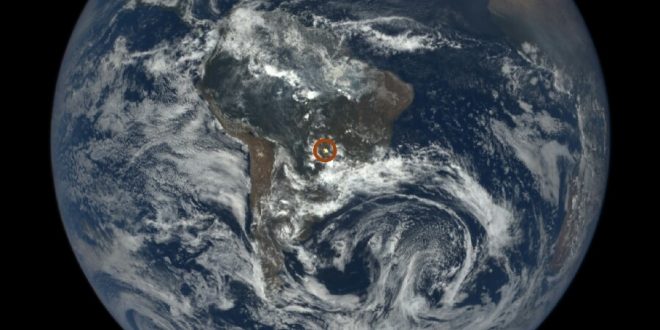A NASA camera has captured hundreds of flashes of light coming from above the Earth’s surface that researchers say are caused by sunlight reflecting off tiny ice particles.
Mysterious flashes of light from Earth were captured by the National Oceanic and Atmospheric Administration’s Deep Space Climate Observatory, or DSCOVR, an Earth and space weather satellite launched in 2015. Eagle-eyed amateur observers noticed the flashes of light, which occurred hundreds of times over the span of a year.
Alexander Marshak, DSCOVR deputy project scientist at NASA’s Goddard Space Flight Center in Greenbelt, Maryland, first noticed light flashes occasionally appearing over oceans as he looked through that day’s EPIC images.
“Large expanses of blue ocean and apparent coastlines are present, and close examination of the images shows a region of [mirror-like] reflection in ocean but not on land,” they wrote of the glints.
Flashes of light reflected off oceans – like those referenced by Sagan – could have a simple explanation, Marshak said: Sunlight hits a smooth part of an ocean or lake, and reflects directly back to the sensor, like taking a flash-picture in a mirror.
But when the scientists took another took a look at the Galileo images, they saw something Sagan and his colleagues apparently missed — bright flashes of light over land as well. And those flashes appeared in the EPIC images as well. As the contact listed on the website that posts all EPIC images, Marshak started getting emails from people curious about what the flashes were.
“We found quite a few very bright flashes over land as well,” he said. “When I first saw it I thought maybe there was some water there, or a lake the sun reflects off of. But the glint is pretty big, so it wasn’t that.”
Instead, he and his colleagues Tamas Varnai of the University of Maryland, Baltimore County, and Alexander Kostinski of Michigan Technological University, thought of water elsewhere in the Earth system: ice particles high in the atmosphere. The scientists conducted a series of experiments, detailed in a new paper published in Geophysical Research Letters, to confirm the cause of the distant flashes.
First, the researchers cataloged all of the prospective sunlight glints over land in images from the EPIC camera. The flashes show up in three distinct colors because the camera takes the red, green and blue images several minutes apart. In all, the scientists found 866 bursts between DSCOVR’s launch in June 2015 and August 2016.
The scientists reasoned that if these 866 flashes were caused by reflected sunlight, they would be limited to certain spots on the globe – spots where the angle between the sun and Earth is the same as the angle between the spacecraft and Earth, allowing for the spacecraft to pick up the reflected light. When they plotted the locations of the glints with where those angles would match, given Earth’s tilt and the spacecraft’s location, the two matched.
This helped confirm that it wasn’t something like lightning causing the flashes, Marshak said: “Lightning doesn’t care about the sun and EPIC’s location.” The researchers also plotted angles to determine that the light was reflecting off of ice particles floating in the air nearly horizontally.
Another feature of the EPIC data helped confirm that the flashes were from a high altitude, not simply water on the ground. Two channels on the instrument are designed to measure the height of clouds, and when the scientists went to the data they found high cirrus clouds, 3 to 5 miles (5 to 8 kilometers) where the glints were located.
“The source of the flashes is definitely not on the ground. It’s definitely ice, and most likely solar reflection off of horizontally oriented particles,” Marshak said.
Detecting glints like this from much farther away than in this case could be used by other spacecraft to study exoplanets, he said. As an Earth scientist, however, Marshak is now investigating how common these horizontal ice particles are, and whether they’re common enough to have a measurable impact on how much sunlight passes through the atmosphere. If so, it’s a feature that could be incorporated into computer models of how much heat is reaching and leaving Earth.
The DSCOVR mission is a partnership between NASA, the National Oceanic and Atmospheric Administration (NOAA) and the U.S. Air Force, with the primary objective to maintain the nation’s real-time solar wind monitoring capabilities, which are critical to the accuracy and lead time of space weather alerts and forecasts from NOAA.
Agencies/Canadajournal

 Canada Journal – News of the World Articles and videos to bring you the biggest Canadian news stories from across the country every day
Canada Journal – News of the World Articles and videos to bring you the biggest Canadian news stories from across the country every day

